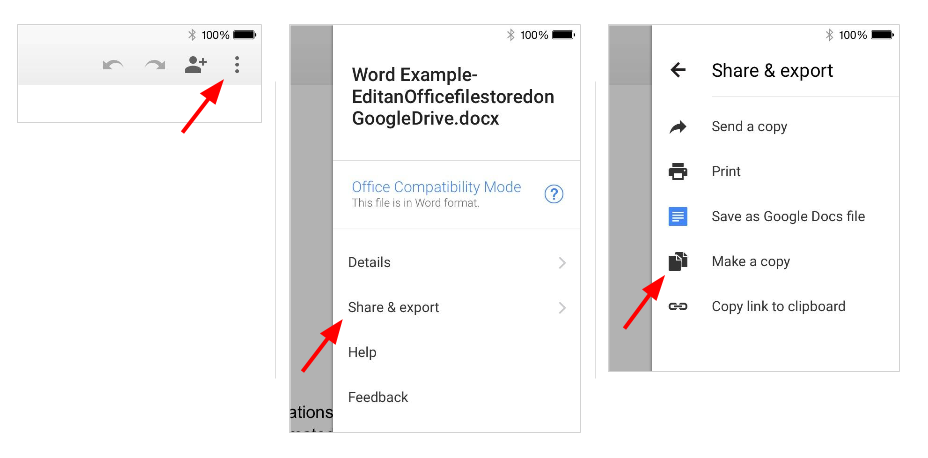
We may earn from vendors via affiliate links or sponsorships. This might affect product placement on our site, but not the content of our reviews. See our Terms of Use for details.
Andy Wolber shows you how to edit Word, Excel, and PowerPoint documents stored on Google Drive from your desktop or mobile device.

Many organizations that rely on Google Apps also use Microsoft Office applications. Mass conversion of highly formatted documents, complex spreadsheets, or animated presentations may not always be practical. As a result, people still open and edit Word, Excel, and PowerPoint documents after a move to Google Apps.
Microsoft Office files, however, no longer need to be stored on your local computer, server, or even on Microsoft’s OneDrive. Google Drive stores Microsoft Word, Excel, and PowerPoint files much like any file server. And Google encrypts the files when you upload them to Drive, and it stores the files in an encrypted state, too.
Google also offers several ways to edit Microsoft Office files stored on Google Drive. Edit capabilities vary by operating system. Here’s a look at the options as of August 2015.
The most full-featured way to edit a Word, Excel, or PowerPoint file stored on Google Drive is with Microsoft Office, of course.
People who use Office on Windows may open Office files from Google Drive with a plug-in. Simply install the Google Drive plug-in for Microsoft Office, and Google Drive will display as a file storage location in Word, Excel, and PowerPoint (Figure A). From within your Office app, open a file on Google Drive, make your changes, then save the file back to Google Drive.
Figure A

You can also open an Office file stored on Google Drive from your Chrome browser–on either Windows or a Mac. First, install the Google Drive app for your system. Next, start Chrome and browse to your file on Google Drive (http://drive.google.com). Right-click (or, [Ctrl]+click) on a Word, Excel, or PowerPoint document, then choose “Open in…” and select the corresponding Office app (Figure B). When you’re done with your edits, the file saves to Google Drive.
Figure B

With Google’s mobile apps for Android or iOS, you can edit an Office document on the go. I suggest you install four apps:
You can create a new Word, Excel, or PowerPoint document with Google’s Android apps, but you must change a setting in each app to enable the feature (Figure C). While in the Google Docs Android app, touch the three-line menu (upper left), tap Settings, then check the box listed below the “Document Creation” section. Repeat the process for all three apps (Docs, Sheets, and Slides).
Figure C

On iOS, you can’t create a new Word, Excel, or PowerPoint file with Google’s apps–you can only view, open, or edit. But there’s a work-around: “Make a copy” of an existing Office file (Figure D). For example, open the Google Docs app on your iPad/iPhone, choose a Microsoft Word file, then tap the three vertical dots in the upper right, tap “Share & export,” then click “Make a copy.” You’ll have a copy of your existing Word .docx format file, which you may then edit. Use the Google Drive iOS app to rename or move the file. The same process works for Excel files in Sheets and PowerPoint files in Slides. Just be sure to keep at least one Word, Excel, and/or PowerPoint format file on your Google Drive.
Figure D

You may make basic edits to any Word, Excel, or PowerPoint document stored on Google Drive with Chrome on the web. Of course, you’ll have fewer edit options than with a native Google file. See the image to compare the Google web edit options for a standard Google Doc and Word file, a Google Sheet and Excel file, and a Google Slides and PowerPoint file (Figure E). In every case, the edit options are fewer.
Figure E

In the early days, I encountered people who found it difficult to work with Office documents stored on Google Drive. Some colleagues of mine would try to open a Word file from within the Google Drive sync folder on their Windows desktop. Sometimes, they’d accidentally convert the file to a Google Doc. Then they’d download a copy of the file–in Word format again–and save it. They would end up with multiple files in various formats.
Google’s desktop and mobile app compatibility with Microsoft Office files has improved. Now, you can open and edit your Office files stored on Google Drive in several ways. And, if you use a Mac or Windows system with Office installed, you can do so with the full editing power of Office.
Does your organization use both Google Apps and Microsoft Office? If so, how do you handle existing Office format files? Share your experience in the discussion thread below.
Affiliate disclosure: TechRepublic may earn a commission from the products and services featured on this page.
From the hottest programming languages to commentary on the Linux OS, get the developer and open source news and tips you need to know. Delivered Tuesdays and Thursdays
From the hottest programming languages to commentary on the Linux OS, get the developer and open source news and tips you need to know. Delivered Tuesdays and Thursdays
Share ArticleAs a consultant, Andy helps nonprofit organizations understand and leverage technology. He taught the Nonprofit and Government Technology class for Grand Valley State University's Public Administration program for several years. His prior experience includes staff positions with Michigan Nonprofit Association, NPower Michigan, the Dallas Historical Society, Dallas Theater Center, Dallas Black Dance Theatre, and volunteer leadership of the Technology Advisory Committee of the Grand Rapids Community Foundation, as well as the Dallas Arts District Friends. Andy lives Albuquerque, New Mexico with his wife, Liz. Their daughter, Katie, is pursuing a graduate degree in education at Vanderbilt University.